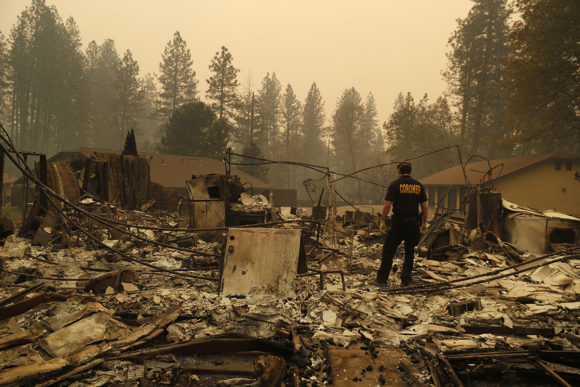The California wildfires of 2018 were devastating, burning hundreds of thousands of acres, costing numerous lives and destroying thousands of properties.
The California Department of Insurance in early December put the official tally for insured losses from the year’s major California wildfires at $9.05 billion. That figure is likely to go higher.
For now the best thing the insurance industry can do is pay claims, and comfort insureds.
But in the long run, the industry and the state can learn a few lessons from the fires, according to Michael Brown, vice president with Golden Bear Insurance Co.
The long-time industry veteran spoke with Insurance Journal about the impact of the fires, including the impact on surplus lines and the FAIR Plan, the state’s property insurer of last resort.
Brown offered up five lessons we can all learn from these events. This has been edited for brevity and clarity.
No. 1: I think the first thing we’re learning is the ability of the residual market in California to respond. The California FAIR plan is being, I guess the term would be, inundated with new applications following the severe wildfire seasons, both in 2018 and 2017, which are driving admitted markets out of the brush-exposed urban wildland interface homeowners business. In addition to the FAIR plan we have a number of non-admitted markets … very active in that space. That is a great example of a system working the way it’s supposed to. Admitted markets have, pardon the pun, been burned by this business, and have pulled away a little bit and the FAIR plan and the surplus markets are stepping in to fill the void.
No. 2: I think it’s a great opportunity for California in particular to revisit building codes and requirements for more fire resistant construction in the wildland urban interface. There are areas that don’t necessarily have any professional fire departments nearby, there’s going to be delays in getting fire support there … so making each home as able to withstand heat and fire as possible might help mitigate some of these losses that we’re talking about.
No. 3: I think it’s a great opportunity for us to learn a little something about forestry management. In the last 30 or 40 years we have done a great job of reducing logging with an emphasis on protecting the environment and keeping sustainable growth in our forest.
The pendulum may have swung a little bit too far because we have, depending on who you talk to, from a couple million to many million dead trees in forests in California. Now, a live tree burns relatively slowly — it’s hard to get the fire started — a dead tree burns like a match. These dead, unharvested trees are creating an opportunity for a fire to really get a foothold, and if there happens to be a number of them in a small area, build up enough heat and enough momentum to catch the live trees nearby on fire. So I think the takeaway here would be for the U.S. Department of Forestry, and California’s Department of the Interior, Agriculture, or whoever it is that’s in charge of that, to step in and say, “We need some responsible harvesting of dead fall and dead standing trees just to help minimize the fuel load and maybe slow down some of these wildfires that they’re spreading.”
No. 4: I think the fourth point, and quite possibly the most serious out of the group, is for the insurance carriers to really monitor their spread of risk. What used to be considered safe from conflagration, these would be homes in some sort of a community with hire hydrants and a fire department, such as Paradise, in California. We’re now seeing with the severity of wildfire in the last few years, these small communities can be overwhelmed and virtually destroyed by a wildfire, which is just moving faster and hotter than even a paid, professional fire service with hydrants and access to water can prevent.
We saw a company not too far from where our company lives, Merced Property & Casualty Co., get themselves in over their heads with too many losses from the Camp Fire around Paradise. We’ve also seen in an AM Best update … another carrier has had their outlook turned to negative due to losses from the wildfires exceeding expectations. So spreading risk, making sure that as a carrier you’re not taking on more exposure than you can reasonably handle, is gonna be a very important lesson to carry forward for all of us.
No. 5: I think the last thing I want leave you with goes out to the agents and brokers out there — there’s still an awful lot of people with homes and businesses in the brush exposed urban wildand interface areas who need insurance.
It’s not going to be as easy to place that insurance … so be ready to dig in a little bit, it’s going to be a little bit harder work to find the right coverage and the right carrier. These people need the insurance. The insurance is out there, it’s just going to take a little extra effort to connect the consumer with the right insurer.
Was this article valuable?
Here are more articles you may enjoy.



 Kansas Man Sentenced to Probation for Insurance Fraud
Kansas Man Sentenced to Probation for Insurance Fraud  AIG’s Zaffino to Step Down as CEO as Aon’s Andersen Steps In
AIG’s Zaffino to Step Down as CEO as Aon’s Andersen Steps In  Howden Buys M&A Insurance Broker Atlantic Group in US Expansion
Howden Buys M&A Insurance Broker Atlantic Group in US Expansion  FBI Involved After Two Florida Injury Lawyers Go Missing From Fishing Trip
FBI Involved After Two Florida Injury Lawyers Go Missing From Fishing Trip 


